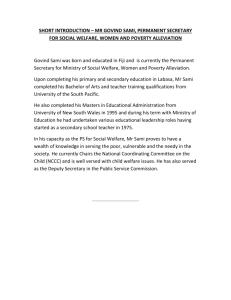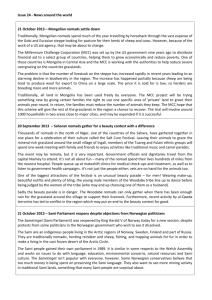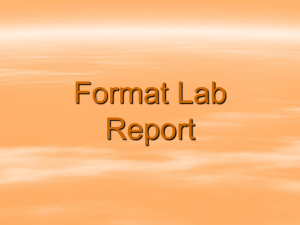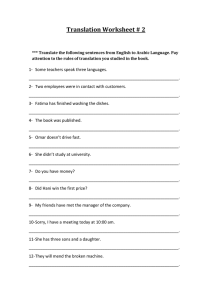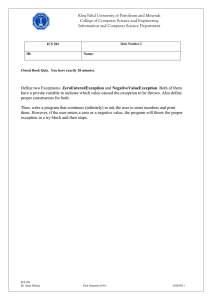PP 1 Thank you, Chair.
advertisement
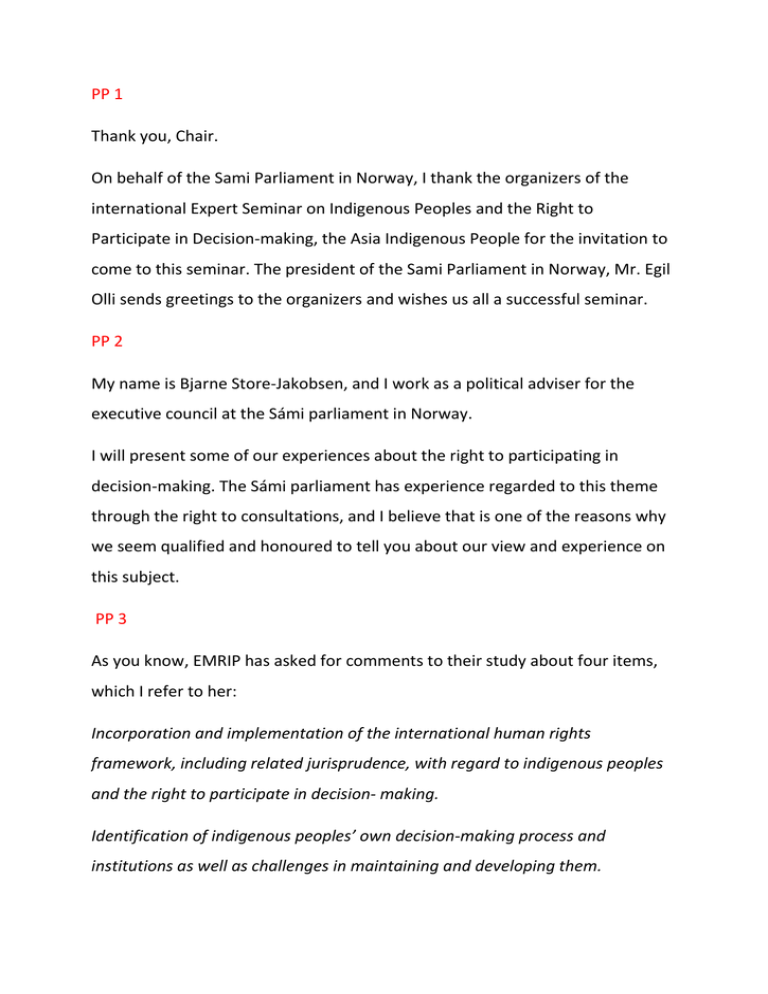
PP 1 Thank you, Chair. On behalf of the Sami Parliament in Norway, I thank the organizers of the international Expert Seminar on Indigenous Peoples and the Right to Participate in Decision-making, the Asia Indigenous People for the invitation to come to this seminar. The president of the Sami Parliament in Norway, Mr. Egil Olli sends greetings to the organizers and wishes us all a successful seminar. PP 2 My name is Bjarne Store-Jakobsen, and I work as a political adviser for the executive council at the Sámi parliament in Norway. I will present some of our experiences about the right to participating in decision-making. The Sámi parliament has experience regarded to this theme through the right to consultations, and I believe that is one of the reasons why we seem qualified and honoured to tell you about our view and experience on this subject. PP 3 As you know, EMRIP has asked for comments to their study about four items, which I refer to her: Incorporation and implementation of the international human rights framework, including related jurisprudence, with regard to indigenous peoples and the right to participate in decision- making. Identification of indigenous peoples’ own decision-making process and institutions as well as challenges in maintaining and developing them. Identification of participatory and consultative mechanism linked to both State and relevant non-State institutions and decision-making process affecting indigenous peoples as well as challenges in their effective implementation. Identification of key measures and challenges related to the efforts to guarantee the right of indigenous peoples to participate in decision-making. PP4 The sami parliament will give comments to these items in next month by 26. February. We are also expecting the State Norway to give their comments on these items. In this presentation I won`t go in detail about this four items, but rather inform you about the samis experiences on this theme. Before I can do that, it is necessary to introduce you about us and our history. PP 5 The Sámi are one of many Arctic indigenous peoples. Other indigenous peoples related to the Sámi are the Inuit in the West and Nenets/Komits In the East. Being an indigenous people means that: - Sámis inhabited the Nordic region, at the time of the establishment of present States boundaries - and that the Sámis has retain some of their own social, economic, cultural and political institutions. Self-identification as indigenous is also regarded as a fundamental criterion for determining our status. PP 6 The Sámi live in four national states: • Norway • Sweden • Finland • Russia The Sámi have a common language, culture and traditions. The Sámi also have common national symbols: • Sámi flag • National day • National anthem PP 7 The Sámis’ settlement area is called Sápmi. Sámi country stretches from the Kola peninsula in the north-east to Engerdal in South Norway and Idre in South Sweden. The Sámis are a minority in numbers in all four national states, but in central Sápmi the Sámis are in the majority. This area is marked in light green with a yellow border. PP 8 The Sámis of Finland, Sweden and Norway today have each their own Sámediggi that protects their interests in the nation at large and acts as an authoritative body internally. Sámediggi in Finland • In Finland the Sameparlament was established already in 1973 and renamed Sámediggi in 1996. • Located in Anár (Enari) Sámediggi in Norway • The Sámediggi in Norway was established in 1989 • Parliament building in Kárášjohka (Karasjok) (Earlier on this power point presentation, on page 1, you saw a picture of the Sámi Parliament building.) Sámediggi in Sweden • The Sámediggi in Sweden was established in 1993 • Located in Girun (Kiruna) PP 9 The conflict over the damming of the Alta River began as early as the 1970s, when the development plans were submitted for the first time. The plan affected vital Sámi territory, and among other things involved the submergence of 200 people’s homes at Masi. In 1973, following a visit to Masi by a Storting committee that was greeted by massive protests, a resolution was passed granting permanent protection of Masi. In 1974 the district councils of Alta and Kautokeino voted to oppose the hydropower scheme; in the same year, however, Finnmark County Council recommended the dam. On 30 November 1978 the Storting passed a plan for the river with a dam at Sávžu. The Storting’s decision led to extensive protests from the Sámi and from environmentalists. The Popular Movement against the Development of the Alta-Kautokeino River was created, and petitions with more than 15,000 signatures were presented to the Storting. In June 1979 the Popular Movement began to employ civil disobedience against construction work at Detsika, near Alta. In October of the same year a group of Sámi underwent a hunger-strike at Eidsvollsplass, the little square just outside the Storting. These demonstrations led to a suspension of the development work. After Alta District Court gave judgement that construction had been lawfully begun, however, work resumed in January 1981, triggering a new campaign of civil disobedience. Protests were stopped by police action. A group of Sámi underwent a hunger-strike from 24 January to 25 February. Construction work was once again halted to determine whether the development was in conflict with the Cultural Monuments Act, but resumed in September 1981 without major interruption. In 1982 the Supreme Court ruled that the development was legal, and the Popular Movement was dissolved in that year. During certain phases of the conflict large numbers of police were stationed in Alta. PP 10 The dam project on the Alta-Kautokeino waterway speeded up the Sámi rights issue in Norway. The Sámi rights struggle received enormous attention in the media in connection with the dam project, and the government appointed two committees to study Sámi rights and cultural issues: the Sámi Rights Committee and Sámi Culture Committee. The Sámi Rights Committee submitted its first part recommendation in 1984, which formed the basis for the Storting resolution in 1987 on a separate Sámi Act and thus the establishment of the Sámediggi. The Storting (the Norwegian Parliament) passed the new Article 110a of the Constitution in 1998. The Sámediggi was officially opened on 9 October 1989 in Karasjok by His Majesty King Olav V. The ILO Convention no. 169 was ratified in 1990. PP 11 The Sámediggi is a political tool for strengthening the Sámi’s political position and contributing toward just treatment of the Sámi people. As an indigenous people, the Sámis are in a different position than other ethnic minority groups in the Nordic countries. Sámis are not immigrants in recent historical times, but lived in the area long before the national states and borders were established. Consequently, the Storting has pronounced that Sámi language and culture must be regarded as an original language and culture in Norway, and have the same entitlement to preservation and development possibilities as the the language and culture of the Nordic majority peoples. An important part of the argument for establishing the Sámediggi is that, by virtue of being a minority, the Sámis cannot achieve their political objectives in the regular democratic bodies based on majority democracy. The Sámediggi was established to remedy this and to give the Sámi a common voice. That does not mean that all the representatives in the Sámediggi agree among themselves, but that decisions are made on the basis of a political process. PP 12 The Sámediggi has decision-making authority in fields of responsibility for which authority the central government has conferred on the Sámediggi, including preservation of Sámi cultural artefacts, education, language, business and industry and culture. The Sámediggi Plenary Session, or the bodies to which such authority is delegated, themselves decide the scope and rules for schemes that they administrate. The Sámediggi distributes its own budget, based on the frameworks set forth by central authorities. Over the past few years the Sámediggi has had several financing schemes transferred over its budget that were previously linked to items in the state budget. As support for the Sámediggi and the real decisionmaking authority on various matters has increased in recent years, the Sámediggi’s opinion on various issues has acquired increasingly greater importance. Therefore, it would be correct to say that the Sámediggi’s de facto influence is greater than the explicit fields of responsibility in which the Sámediggi has final decision-making authority. This is formalized by the fact that, in more and more cases, the Sámediggi is a mandatory hearing body for various matters. PP 13 Today the Sami Parliament in Norway works in a partnership with state authorities. The agreement on consultation procedures was signed on 11 May 2005 by Erna Solberg, former Minister of Local Government and Regional Development, and Sven-Roald Nystø, former President of the Sami Parliament. PP 14 The consultation agreement is largely a specification of the obligations that have been incumbent since Norway signed ILO-169 in 1990, on central government authorities in respect of the Sami as an indigenous people. The State is obligated to consult with the Sami Parliament on issues that are, or may be, affected directly because of legislative or administrative measures are considered given, ILO art 6. On the other hand the sami parliament isn`t committed to consult on every cases that directly affects the sami people. We have in fact the opportunity to choose not to consult with the state. Sometimes we choose instead to give a submission to the case (høringssuttalelse). Or we consider the matter as with small, or non, influence on the sami peoples situation with no need for consultations. The first time there was agreement that actual consultations were taking place was during the process leading to the Finnmark Act in 2005 PP 15 International law contains several different sources of law that govern indigenous peoples' participation, self-determination and consultations. It is first and foremost the consultation rules in the ILO Convention that lay the foundation for the consultation agreement. But also the international Covenant on Civil and Political Rights (1966) and the United Nations Declaration on the Right of Indigenous People (2007) has rules concerning the Right of Decisionmaking. PP 16 From a legal point of view, the rules of co- and self-determination will nonetheless be relevant supplementary interpretive factors during the practice of this agreement. In cases where the parties are insecure about how the agreement shall be interpreted, the international law will be normative. PP 17 The purpose of the consultation agreement is to: • ensure practical implementation of the ILO Convention • Establish rules for the procedure between the parties in the Decisionmaking-process, and in best way to preserve their common and/or different interests • achieve agreement in good faith. The term “good faith” means that the parties shall not try to trick each other, and that they shall try explain and understand the interests of each other. You can ask questions about your attitude and role in the consultation/process: “Is this a procedure I would have been using towards my friends when concluding an agreement?” Or: “Would this choose of procedure in this consultation-process been an embarrassment for mine party if it was published in the paper?” To achieve agreement means that the parties shall: a) listen to each other, b) speak for the purpose that the other party shall understand the meaning of the spoken word and c) only give expressions with a meaning. The parties seek to clarify their interests, justifications and reviews. • facilitate the development of a partnership perspective • develop a joint understanding of the needs of the Sami community PP 18 The scope is that: • The procedures apply in cases that may directly affect the Sami People. • It is enough that it is reasonably likely that an act or an initiative will have a direct effect. • In cases of a general nature that must be expected to impact society as a whole, the consultation obligation will generally not apply. PP 19 Information shall be furnished: 1. as early as possible in connection with cases that can affect the Sami directly 2. The Sami Parliament shall give feedback as soon as possible on whether it is desirable that further consultations be held, and point out any other problems for discussion the case might raise PP 20 Relevant and complete information must be provided at all stages of the case. The authorities are responsible for ensuring that the information is presented so that substance of the case is understood. PP 21 Consultations are to take place in good faith and for the explicit purpose of achieving agreement The Sami Parliament is to have an opportunity to exert genuine influence on the process and the result. Consultations are more than a hearing The parties are required to try to reach to an agreement. PP 22 Several consultation meetings can be held, if so required. Cases shall not be concluded as long as the Sami Parliament and the State agree that it might be possible to reach agreement. Where it is not possible to reach agreement, distinct reasons must be cited for the parties' different assessments and points of view. In cases that involve other State activities, the responsible party must ensure that the cases are cleared in the usual manner PP 23 In cases prepared by subordinate agencies, the consultations that have taken place with different agencies must be viewed in context. Information about the Sami Parliament's opinions and what the parties have agreed shall always accompany a case. The Sami Parliament will often need to know how local Sami communities and organisations feel about an issue before further consultations can be held. Clarification must be reached with the Sami Parliament on an expedient plan with regard to such issues. PP 24 Minutes shall be kept of all consultation meetings between central government authorities and the Sami Parliament. The minutes shall include a brief statement on what the case refers to, the parties' assessments and points of view, and the conclusion. PP 25 Consultations with other Sami interest groups is also an obligation due the agreement • Pursuant to the ILO Convention, there may be an obligation to consult with other parties in addition to the Sami Parliament. • Coordination of the consultations must be discussed with the Sami Parliament PP 26 Reindeer husbandry is an example of an sami interest group. Reindeer husbandry has a separate representative agency and a tradition of representing itself PP 27 When it comes to legislation and regulations, it would be natural to consult the Saami Reindeer Herders' Association in Norway (NRL). As regards specific encroachment cases, the individual rightsholder should be consulted, usually through a representative of the individual reindeer grazing district. PP 28 Other Sami interests Point of departure: The Sami Parliament safeguards the interests of different local Sami groups; like the east-sami, sea-samis, sami children, sami handicraft-workers, In certain cases, it might be relevant to consult the Sami community through representative spokespersons. This is most appropriate when the group in question has a strong desire to speak for themselves. East sami: As an example of this situation we can mention that we expect the State to have consultation directly with the east- sami-people, which is a small group of samis in northern-Norway. This group has its population mostly living in Finland and Russia. Their language is strongly threatened and if not any action will be taken in preserving their culture and language, it`s mostly sure that the east-sami peoples language and culture will soon disappear. In dealing with this situation we believe a good tactic will be for the State to consult directly with this people, and also with the Russian and Finnish government. The State Norway has an action plan to preserve the sami peoples language and culture. There is work going on in preserving the east-sami language and culture. The sami parliament will monitor this work, and if wanted we can participate in the consultation-process as an observer, and we can have dialog with the State about the coordination of the consultations between State and east-sami people. BUT: The authorities can not choose solely to consult parties that agree with them. The international law, and the agreement, don`t allow other practise than what the law has stated: Sami people that are, or may be, affected directly because of legislative or administrative measures are considered given shall be consulted, ILO art 6. The samis shall participate in the formulation, implementation and evaluation of plans and programmes for national and regional development which may affect them directly, ILO art. 7. Also shall the Government take measures, in co-operation with the sami peoples concerned, to protect and preserve the environment of the territories they inhabit, ILO art. 7. PP 29 The sami parliament experience on the right of Decision-making has it`s start from 2005, when the first consultation was taken in the process of the Finnmark act. Our experience is about 5 years “old”, and contains both positive and negative outcomes. Positive experiences are legislation we have achieved that protects, preserves and strengthens the Right of the sami people like in the Nature Management Act (naturmangfoldsloven) and the Planning- and Building Act (plan- og bygningsloven). Though we have the consultation agreement and the international legislation on the Right to Participating in the Decision-making, we still have many challenges to overcome. In the future we would like to have a legislation on our right to consult, and the consultation-process. We consider our consultation agreement as a temporarily stage in implementing the international law in our national legislation. Despite the fact that we have a consultation agreement with the State, we still experience challenges when practising content in the agreement. We have cases where the government departments have not consulted with us in good faith in the purpose to achieve an agreement. We have experienced meetings have been cancelled, or not held at all, followed with the department making conclusions that it is impossible to get to an agreement. Such a conclusion have been based on minor issues because the ministery hasn`t really tried to obtain an agreement with us. In those cases hasn`t the State applied their obligations, considering they are committed to consult the sami people. In the mining act case we experienced this situation. The Sami parliament responded to the act with the plenary voting no to supporting the closure of the mineral act. The mining-case example shows us that there is still a need for raising awareness and knowledge of Sami issues in ministries and agencies. We have an ongoing process dealing with the Sami rights in the areas south of Finnmark. We expect a speedy process by the government which ensures no further loss of lands and resources for the Sami in these areas. Also we expect the government to follow up the report presented in 2008 dealing with Sami and local rights to the fisheries in the fiords and coastal waters in the northernmost sami areas of Norway. There is an urgent need for acceptance of the sami rights to the marine resources, otherwise the coastal sami culture and way of living will disappear. The consultation right is a strong political tool that will be used in the meaning of preserving these sami rights. The Sami parliament will use our right to consult with the State in purpose to get to an agreement with the State in those cases. In other cases we don`t have any consultations with the State, but we are in dialog with the government. An example of this is the fact that Indigenous peoples are particularly vulnerable in a climate change context. The Sami parliaments are acutely aware that climate change may increase pressures to engage in industrial development in outlying areas. It`s important for us to ensure that indigenous rights are respected and protected when climate measures are implemented. In Sami territories we have noticed this, for example, in the form of more planning and development of wind power onshore, accompanied by power lines, roads and other infrastructure that adversely impacts Sami interests, especially reindeer husbandry. Our point is that it is entirely possible to combine the Sami's sustainable use of nature with the appropriate development of clean energy for the future. We believe that indigenous peoples can be part of the global climate solution if we are empowered and put in a position to participate in the processes that address climate change and promote green energy. (Our job is to protect the land that ties us to the past and our history. It is the natural landscape that furnishes the basis for our stewardship of resources and our grazing animals. The land, air, water, oceans, forests, sea ice, plants and animals is the source of indigenous peoples' values and the land imbues us with the identities that distinguish us as separate nations. We are talking about our common future.) The indigenous peoples of the world need to be included in decisions that will shape the future and promote the best interests of our cultures. The Saami Parliamentary Council expects the UN Declaration on Indigenous Rights to serve as the basis for all initiatives associated with national and international processes related to climate changes, adaptation and mitigation measures that have a direct impact on indigenous peoples. Including the principle to obtain free, prior and informed consent from the affected indigenous peoples before states take any legislative or administrative measures. Lastly I will refer to more information about our experiences on the right to consult in “the Sami Parliament`s supplementary report to the UN Human right Committee of November 2009”. Thank you.
